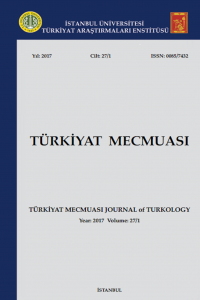Abstract
The conditions under which historical events happen,
reactions that society shows against these events and feelings of people
reflect on literary texts. Literary texts can never reflect the reality as it
is. To expect these texts to do that is contrast to the nature of art. Literary
texts are the piece of works that are woven around the beauty, and their aim is
to present whatever they tell in an aesthetical way. All elements of life can
find a place for themselves here to the extent they beautify and deepen the
text since the main factor of these texts is beauty.
In
addition, literary texts are created by a writer, who has a certain position in
the middle of certain relationships system in a specific society. Although
writer’s aim is not to transfer the society, relationship system in this
society, and main belief and thinking ways of this society, these elements also
take place in the text. The mindset factors, which are imbedded in the text,
establish the background of the text. Structures, which come from living in a
specific region and in a certain social system but are not aimed at being
transferred directly by writer, help to understand the period that the text is
written. Most of the time, elaborate details about the period that the text is
written are needed to analyze these structures.
Eulogies’ being written for statesmen and clergymen
naturally puts these texts into the category of historical texts. With the
reasons of being written, they turn into evidences that witness an event and
reflect the effects and results of this event. Many elements like the time of a
conquest, a structure’s year of built, the reasons and type of a military
expedition, state-artist relationships, the state and ruler model in the minds
of public directly or indirectly take place in eulogies. Since eulogies are
written by an artist, naturally, reality about these matters turns into an
aesthetical reality and melts in it. In addition, it can be stated that
eulogies, compared to other genres, transfer the reality that has been formed
around the ruling of the period more directly.
In this study, three eulogies
that Fuzûlî presented to Ayas Pasha because of his Basra Expedition are
analyzed. Through these three aforementioned eulogies, the phases of Basra
Expedition are explained.
Keywords
References
- ARMAĞAN, A. Latif, “XVIII. Yüzyılda Hac Yolu Güzergâhı ve Menziller (Menâzilü’l-Hacc), Osmanlı Araştırmaları, İstanbul, 2000, Sayı XX, Sayfa 73-118.
- BALTACI, Cahid, “Basra Körfezi ve Hicaz İçin Osmanlı-Portekiz Mücadelesi”, Marmara Üniversitesi İlâhiyat Fakültesi Dergisi , 1987-1988, Sayı 5-6, Sayfa 156-163.
- DEMİRTAŞ, Funda, “1701 Basra Seferi Osmanlı Ordusunun Yürüyüşle Sağladığı İtaat, İstem, 2013, Sayı 21, Sayfa 81-102.
- EROĞLU, Cengiz, Murat Babuçoğlu, Orhan Özdil: Osmanlı Vilayet Salnamelerinde Basra, Ankara, Orsam, 2012.
- İVANOV, Nikolay, Osmanlı’nın Arap Ülkelerini Fethi 1516-1574 [Çevirenler: İlyas Kemaloğlu, Rakhat Abdieva], Ankara, Atatürk Kültür Dil ve Tarih Yüksek Kurumu Türk Tarih Kurumu Yayınları, 2013.
- FUZÛLÎ, Fuzûlî’nin Türkçe Divanı (Yayımlanmamış Doktora Tezi) [Hazırlayan: Abdulhakim Kılınç], İstanbul Üniversitesi Sosyal Bilimler Enstitüsü, İstanbul, 2017.
- MILES, S. B., Countries And Tribes Of The Persian Gulf, London, 1920. RÜSTEM PAŞA, Rüstem Paşa Târihi (H. 699-968/M. 1299-1561) (İnceleme-Metin, vr. 120b-vr.293b) [Hazırlayan: Göker İnan], İstanbul, Marmara Üniversitesi Türkiyat Araştırmaları Enstitüsü Türk Tarihi Anabilim Dalı Yeniçağ Tarihi Bilim Dalı Basılmamış Yüksek Lisans Tezi, 2011.
- SAĞIRLI, Abdurrahman, “Cezâyir-i Irâk-ı Arab veya Şattü’l-Arab’ın Fethi Ulyanoğlu Seferi 1565-1571”, İstanbul Üniversitesi Edebiyat Fakültesi Tarih Dergisi, 2005, Sayı 41, Sayfa 43-94.
- ÖZBARAN, Salih, “XVI. Yüzyılda Basra Körfezi Sâhillerinde Osmanlılar Basra Beylerbeyliğinin Kuruluşu”, İstanbul Üniversitesi Edebiyat Fakültesi Tarih Dergisi, 1971, Sayı 25, Sayfa 51-72.
- WILSON, Arnold T., The Persian Gulf An Historical Sketch, Oxford, 1928.
Abstract
Keywords
References
- ARMAĞAN, A. Latif, “XVIII. Yüzyılda Hac Yolu Güzergâhı ve Menziller (Menâzilü’l-Hacc), Osmanlı Araştırmaları, İstanbul, 2000, Sayı XX, Sayfa 73-118.
- BALTACI, Cahid, “Basra Körfezi ve Hicaz İçin Osmanlı-Portekiz Mücadelesi”, Marmara Üniversitesi İlâhiyat Fakültesi Dergisi , 1987-1988, Sayı 5-6, Sayfa 156-163.
- DEMİRTAŞ, Funda, “1701 Basra Seferi Osmanlı Ordusunun Yürüyüşle Sağladığı İtaat, İstem, 2013, Sayı 21, Sayfa 81-102.
- EROĞLU, Cengiz, Murat Babuçoğlu, Orhan Özdil: Osmanlı Vilayet Salnamelerinde Basra, Ankara, Orsam, 2012.
- İVANOV, Nikolay, Osmanlı’nın Arap Ülkelerini Fethi 1516-1574 [Çevirenler: İlyas Kemaloğlu, Rakhat Abdieva], Ankara, Atatürk Kültür Dil ve Tarih Yüksek Kurumu Türk Tarih Kurumu Yayınları, 2013.
- FUZÛLÎ, Fuzûlî’nin Türkçe Divanı (Yayımlanmamış Doktora Tezi) [Hazırlayan: Abdulhakim Kılınç], İstanbul Üniversitesi Sosyal Bilimler Enstitüsü, İstanbul, 2017.
- MILES, S. B., Countries And Tribes Of The Persian Gulf, London, 1920. RÜSTEM PAŞA, Rüstem Paşa Târihi (H. 699-968/M. 1299-1561) (İnceleme-Metin, vr. 120b-vr.293b) [Hazırlayan: Göker İnan], İstanbul, Marmara Üniversitesi Türkiyat Araştırmaları Enstitüsü Türk Tarihi Anabilim Dalı Yeniçağ Tarihi Bilim Dalı Basılmamış Yüksek Lisans Tezi, 2011.
- SAĞIRLI, Abdurrahman, “Cezâyir-i Irâk-ı Arab veya Şattü’l-Arab’ın Fethi Ulyanoğlu Seferi 1565-1571”, İstanbul Üniversitesi Edebiyat Fakültesi Tarih Dergisi, 2005, Sayı 41, Sayfa 43-94.
- ÖZBARAN, Salih, “XVI. Yüzyılda Basra Körfezi Sâhillerinde Osmanlılar Basra Beylerbeyliğinin Kuruluşu”, İstanbul Üniversitesi Edebiyat Fakültesi Tarih Dergisi, 1971, Sayı 25, Sayfa 51-72.
- WILSON, Arnold T., The Persian Gulf An Historical Sketch, Oxford, 1928.
Details
| Journal Section | ARTICLES |
|---|---|
| Authors | |
| Publication Date | June 21, 2017 |
| Published in Issue | Year 2017 Volume: 27 Issue: 1 |
Cite

